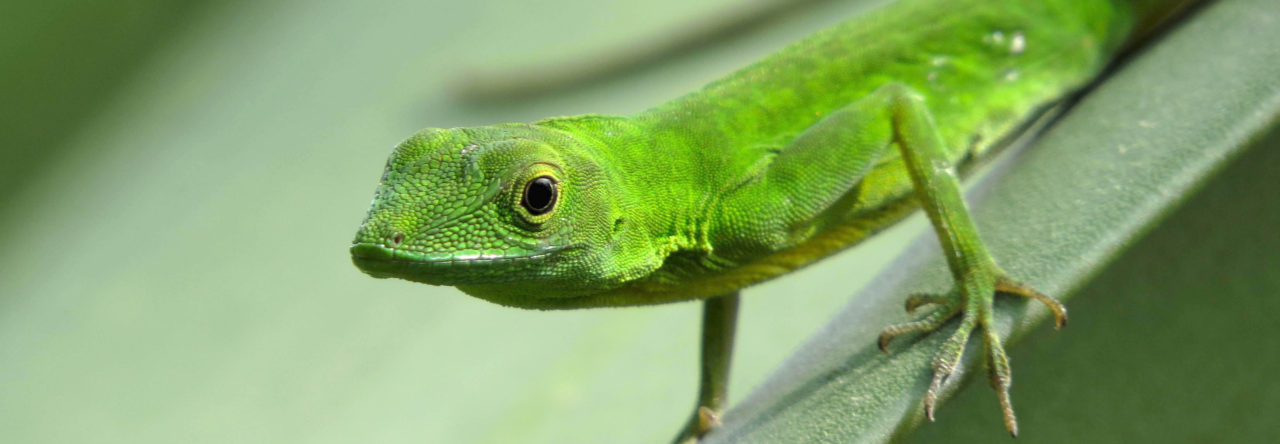
Not a dewlap? Photo by Morley Read.
In a recent paper, Hagman and Ord discussed how dewlaps have evolved multiple times, often with different underlying anatomy. This is an excellent paper, but I was intrigued that Polychrus, sometimes considered the sister taxon to anoles, in part because of its apparently anole-like dewlap (see above), was not considered to have a dewlap.
I wrote Terry Ord, asking “I didn’t understand one thing. You seem to say there is no evidence for extendible dewlaps in several species of Polychrus, but a quick Google reveals plenty of images of these species with dewlaps extended. I take your point in the previous sentence that actual observations of the dewlap being used are rare, but did you really mean to say that they don’t exist at all?”
Terry responded: “What I found when attempting the first paper of this series (Ord et al. 2015, Journal of Evolutionary Biology) is that relying on photos alone is really problematic for identifying a moveable dewlap (a.k.a., a dewlap like anoles or Draco or Sitana).
For example, if you google Sceloporus — who definitely don’t have dewlaps — you’ll find photos where species do appear to have something like a small dewlap. In fact, I found an image of what was clearly a Sceloporus that looked to have an engorged throat that was remarkably similar to your Polychrus photo… All the google images I’ve found so far that are obviously Polychrus (and not anoles) could quite easily be engorged throats akin to Sceloporus and other non-dewlaped iguanids/agamids.
But the clincher for me is that all the hyoids we’ve looked at so far for both Sceloporus and multiple species of Polychrus (and other non-dewlaped iguanids/agamids) all look very similar (e.g., see Fig 5a in the JEB paper and supplementary info). The point being, the mechanics of the hyoid simply isn’t functional in the capacity of extending a dewlap like in anoles and others.
Of course, while the mechanics of the hyoid in extending the dewlap in anoles is well described, how Draco do it and some other genera is unclear. I’m hoping someone will look into detail on the biomechanics of the dewlap extension in non-anole groups because it can clearly be very different to anoles — e.g., the attachment points for key muscles for the anole dewlap are absent in Draco, so they’re sticking that dewlap out using a very different mechanism. Regardless, there are still key signs in the hyoid that point to a moveable dewlap in Draco (and other genera) that are not present in Polychrus.
Proof of a Polychrus dewlap would have to be a video of a Polychrus extending the dewlap because videos of Sceloporus quickly reveal that its an engorging (“puffing”) of the throat, so direct observation is a solid alternative to looking at the hyoid.
The taxonomy of “Polychrus” is potentially sketchy and not all species really are of that genus. Which means I also wouldn’t be surprised to see a species that has been classified Polychrus, but really isn’t related to all the Polychrus species we’ve examined the hyoids of, actually having a convincing moveable dewlap.
But at the moment, Polychrus = a moveable dewlap, all the evidence says otherwise. I also wonder whether the historical association of Polychrus as basal to anoles resulted in reaffirming wishful thinking field observations into the current myth.”
Terry’s next email made the distinction clear (as well as his unwarranted agama-philia): “If your notion of a dewlap is a prominent ornament that is dynamic in some sense (becomes extended through puffing out the hyoid in general or pushing out the CII in particular), then there are many many examples in agamids, and a handful in iguanids. I would definitely include Sceloporus, too.
If your notion of a dewlap is more specific to something that is part of a complex behaviojral display and involves rapid extension of a structure that is complex in temporal and amplitude characteristics, then it’s basically anoles, Sitana/Otocryptis, Draco and possibly one or two other agamids.
Agamids still clinch the diversity stacks in all regards – ha!”

Also not a dewlap








 We’ve seen
We’ve seen 






